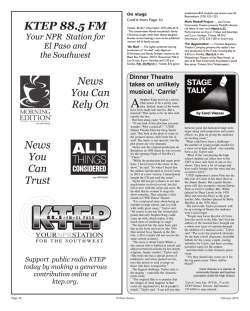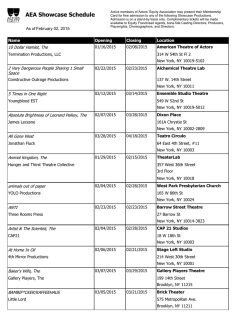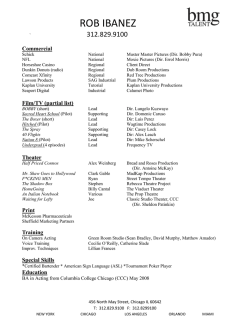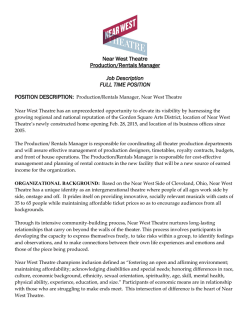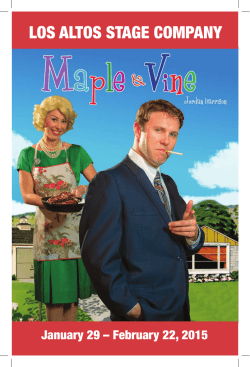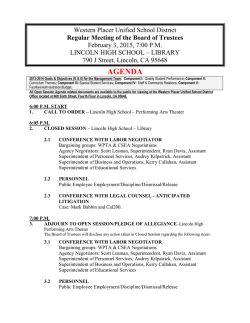
Teacher Resource Guide
2014-2015 Performance Series Educate. Inspire. Entertain. Tall Stories of London Presents: The Gruffalo’s Child In this Guide: Before the Show Activities After the Show Activities Florida Standards Thursday, February 5, 2015 10:45 a.m. The Mahaffey Theater at The Duke Energy Center for the Arts Class Acts Teacher Resource Guides are sponsored by The Mahaffey Theater at the Duke Energy Center for the Arts and the Bill Edwards Foundation for the Arts. How to Reach Us April Minor Class Acts, Mahaffey Theater Education & Community Arts Coordinator 400 1st Street South Coordinating Editor St. Petersburg, FL 33701-4346 Kim Dennison Attn: Class Acts/Perkins Elementary School Curriculum Research & Design Pony Route #3 Phone: (727)892-5800 Fax: (727)892-5770 Directions to the Mahaffey Theater: Take I-275 (south from Tampa, north from Bradenton/Sarasota to exit 22 (I-175) Follow Route I-175 (it will become 5th Street South) to 1st Street South. The Mahaffey Theater will be in front of you. Follow the directions given by the parking attendants. *1st Street South and 2nd Street South are two-way streets. Entering the Theater: Arrive 20 minutes early. Proceed to entrance for your group and look for the sign in table (a designated representative must sign in for the group). Ushers will seat groups on a first come, first served basis. The restroom may be visited after being seated. Please escort young students. Exiting the Theater: Ushers will help your group move out of the theater. You will be directed to the parking areas via various routes. Exiting the theater may be different than your entrance path. Please follow the ushers’ directions. Tall Stories Tall Stories theatre company is a not-for-profit charitable organization, which presents old, new and timeless stories in a physical, visual style, always acknowledging the presence of the audience. Our productions link original music with dynamic movement – and lots of laughs. The company was founded in 1997 by directors Olivia Jacobs and Toby Mitchell. The Book The Gruffalo is an adaptation of the picture book by Julia Donaldson and Axel Scheffler (‘a modern classic’ The Observer). The picture book won Scottish-born Julia Donaldson the Smarties Book Prize Gold Award and the Blue Peter Award for Best Book to Read Aloud. Julia opened World Book Day 2001 with a rendition of the Gruffalo Song at the Traverse Theatre. Every primary school in Scotland received a copy of the Gruffalo Song to sing in school assembly on World Book Day. The book has been the best selling children’s book in the UK for five years running. The Story A mouse strolls through a wood, meeting a fox, an owl and a snake. They all try to eat him, but he scares them away with stories of the terrifying Gruffalo. Then he bumps into a real-life Gruffalo… The quick-thinking mouse explains that he is the scariest creature around and he takes the Gruffalo back through the wood to prove it. When the other animals see the Gruffalo they run away. The Gruffalo gulps in fear and escapes… Theatrical Style Tall Stories has used The Gruffalo as a starting point for our story. Whilst we utilise all the rhymes in the book, we also use imaginative storytelling, physical representation of the animals, original new songs and a lot of giggles. The Gruffalo is scary fun for children aged 3 and up, and their adults… Before the Show Activities Pre-K to 1st Grade 1. Read the story The Gruffalo’s Child. A copy of the text can be found here: http:// frombooksofpoems.blogspot.com/2007/03/gruffalo-by-julia-donaldson.html. 2. Complete a story map for The Gruffalo’s Child (characters, setting, problem, solution). 3. Sing The Gruffalo Song: He has terrible tusks and terrible claws And terrible teeth in his terrible jaws. He’s the Gruffalo! Gruffalo! Gruffalo! He’s the Gruffalo! He has knobbly knees and turned-out toes, And a poisonous wart at the end of his nose. He’s the Gruffalo! Gruffalo! Gruffalo! He’s the Gruffalo! His eye are orange , his tongue is black, He has purple prickles all over his back. He’s the Gruffalo! Gruffalo! Gruffalo! He’s the Gruffalo! He’s the GRRRRRRRRR………Gruffalo! He’s the Gruffalo! Repeat 2nd to 3rd Grade 1. Read the story The Gruffalo’s Child. A copy of the text can be found here: http:// frombooksofpoems.blogspot.com/2007/03/gruffalo-by-julia-donaldson.html. 2. Complete a story map for The Gruffalo’s Child (characters, setting, problem, solution). 3. Perform the Reader’s Theater found at http://www.hkedcity.net/iclub_files/a/1/62/ webpage/09-10/2009_LRA/LRA2009-T501_RTScriptsTheGruffalo.pdf. All Grade Levels Visit the Gruffalo Homepage for activities and to meet the author. http://www.gruffalo.com/ Preparing for the Theater Experience The theater experience is a special one. Have a discussion about theater etiquette. Ever been in a lunchroom when everyone is talking at once? Imagine what that's like for a moment. The sounds of students calling to one another across tables, wrappers are being torn off ring dings, drink cans tops are popping. You get the picture, right? Now imagine trying to tell a story or share a joke with the whole room while all this is going on. It would be pretty near impossible, right? That's why theater etiquette is so important. In order for everyone to enjoy the story unfolding on stage, everyone in the room needs to agree to a certain code of behavior. That behavior is called theater etiquette. When you enter the theater, you agree to the following things: ▪ You agree to be on time. Theater is great! It's live! It happens in the moment. You can't rewind it. You are an important part of the show and you need to be there from the very beginning. The actors are there, so you need to be there, too. Arriving 20 minutes before show time is the standard rule. ▪ If you are late , you agree to wait until a break in the action on stage to be seated. Finding your seat after the show has begun causes a disruption that not only distracts those in the audience, but those who are performing on stage as well. The theater experience is not like the movies. Live people are on stage. They can hear you just like you can hear them. ▪ You agree to use the restroom before the show starts to avoid getting up and disrupting the performance while it's happening. Once a class is seated, you may visit the restroom in small groups prior to show time. Young students must be escorted. ▪ You agree not to talk or whisper during the show . If you whisper to your friends during the show, you disrupt those around you, and quite possibly the actors. And, you might miss something! ▪ You agree not to talk to the actors while they're performing . Again, this is a live performance and the actors are concentrating on giving you the best performance possible. ▪ You agree to participate . This includes laughing at appropriate times, clapping in appreciation for the things and actors you like, and doing other things when invited by the actors to do so. It also means paying attention to what's going on by listening and watching closely. ▪ You agree to turn off all cell phones, watches, game boys and other gadgets that may make noise during the show . No headphones either! These can be just as disruptive as talking! ▪ You agree not to take pictures or use recording devices of any kind during the show . The material performed on stage is copyrighted material, and therefore protected under copyright law from reproduction of any kind without written permission. In addition, the Mahaffey Theater is a union house, and union rules prohibit the use of photography and recording devices without prior consent. ▪ You agree not to eat or drink anything while the show is going on. Remember the lunchroom? Candy wrappers make more noise than you think during a quiet moment on stage and the noise is very distracting to other audience members. ▪ You agree to keep your hands to yourself . Touching other people during the show is distracting, and may lead to talking. ▪ You agree to keep your feet on the floor. Think about how nice it felt walking in to this beautiful space, and how cushy and comfortable the seat felt as you sat down in it. We want everyone to experience this. In order to make that happen, we need to take good care of it. If feet are constantly placed on seats and armrests, they won't look nice for very long. Please be courteous and respectful of your surroundings. ▪ Finally, you agree to give the actors a full curtain call . A curtain call is the actors' final bow at the end of the performance. It's your opportunity to show your appreciation for what they've shared with you. Please wait until all the actors have taken their final bow before exiting the theater. The ushers will assist you in finding the best route out of theater! Follow their directions! These tips can be found at www.stpeteclassacts.com/images/Theater-etiquette.pdf. After the Show Activities Pre-K to Kindergarten This production of The Gruffalo uses a variety of physical theatre techniques to create lots of different characters with three actors and a minimal set. The following ideas aim to encourage children to think imaginatively about the story that they have seen. Monster Pics ‘A Gruffalo? What’s a Gruffalo?’ ‘A Gruffalo! Why, didn’t you know? He has terrible tusks and terrible claws And terrible teeth in his terrible jaws.’ The Mouse in the story imagines a monster to scare away the other animals. Ask the children to draw pictures of their own invented monsters (with labels showing tusks and claws, etc, if applicable). Sounds Good Using the pictures that the children have created, ask the class to create a monster noise for each picture. Can they create very different sounds or do all monsters sound the same? Do the same for other characters in the story – what noises do foxes, owls, snakes and mice make? In the play, the characters each have vocal traits. Fox has a cockney accent and speaks quite fast, Owl speaks slower and his voice is influenced by a ‘twit twoo’ sound, and Snake’s accent is very obvious. Take this exercise one step further – if other animals could speak English, how would they talk? Where did you get that hat? In the play, the animals are suggested by different costumes. To simplify this, ask the children what kind of hats specific animals would wear. Can they make them out of card and felt tip pens? Kindergarten to 3rd Grade This production of The Gruffalo uses a variety of theatre techniques to create lots of different characters with three actors and a minimal set. The following ideas aim to encourage children to think imaginatively about the story. The exercises are very similar to the ones we use when creating a show! Thinking in Pictures To get things moving, split the students into two groups and, as a team game, give them a variety of ‘situations’ that they have to portray in a ‘photograph’. The teams have 5 seconds to create each picture and the best picture wins a point. Sample situations are: climbing, swimming, tea party, space, the zoo. Move on to places and situations from The Gruffalo, perhaps using the deep dark wood, the owl’s nest, the fox meets the mouse, etc. This will allow students to think about how to create a ‘story’ visually, on the stage. Telling Tales For The Gruffalo, we used a picture-book as our starting point – but sometimes we start with nothing. Try coming up with your own story to act out. Going round the class ask each student to tell one word of a story. For example: Student 1: There Student 4: big Student 7: who Student 10: buy Student 2: was Student 5: green Student 8: went Student 11: a hundred Student 3: a Student 6: giant Student 9: to Student 12: sausages... ... and so on. Once everyone has added a word, split the class into groups of five or six and tell them that they have five minutes to show the other group their version of the story. See what they come up with! It will be interesting to see how different their renditions of the same story may be. Looking Good How can we make a character come alive on stage? How do you determine the way that a character stands, moves and speaks? Ask two students (A and B) to stand in front of the class. Ask a third and fourth student to manipulate their arms and legs and faces, moving them from a neutral position into a character. Perhaps these characters stoop, or lean back, or have their head held high. Ask Student A and B to try to create a voice to match their new positions. Would the character have a squeaky or a low voice? How fast or slow would they speak? Do they have an accent? Try different things. Does a big character need a big voice? What happens if you give a small character a booming voice? Ask the rest of the class to vote on which voice best matches the character. Using this idea, ask the students to work in pairs to create two characters from pre-prepared character names. Students can create characters based on animals (Mr Hippo, Ms Snail, Mr Rat...) or create from emotions (Ms Cool, Miss Miserable, Terrified Tom etc). Encourage the students to try to use more than their faces to create the character, thinking about how heavy they are, how fast they can move, how straight/bent their legs are etc. Allow the students to create their own characters in this way and then introduce them to the group. Whose Story is it Anyway? Taking the story of The Gruffalo (or perhaps another pre-selected tale) discuss what happens if you tell a story from different points of view. For example, in the story of the Gruffalo – what would the story be like if told from the point of view of the fox? Or the Gruffalo? Or if the mouse was telling the tale to his mates? Ask different students to tell the story using the first person from different perspectives. Do all the characters have the same version? Are there things that a particular character doesn’t know? Florida Standards LAFS.K.RL.1.3 With prompting and support, identify characters, settings, and major events in a story. LAFS.1.RL.1.3 Describe characters, settings, and major events, in a story, using key details. LAFS.2.RL.1.3 Describe how characters in a story respond to major events and challenges. LAFS.3.RL.1.3 Describe characters in a story (e.g., their traits, motivations, or feelings) and explain how their actions contribute to the sequence of events. LAFS.K.SL.2.5 Add drawings or other visual displays to descriptions as desired to provide additional detail. LAFS.1.SL.2.5 Add drawings or other visual displays to descriptions when appropriate to clarify ideas, thoughts, and feelings. LAFS.2.RF.4.4 Read with sufficient accuracy and fluency to support comprehension. LAFS.3.RF.4.4 Read with sufficient accuracy and fluency to support comprehension. TH.K.C.3.2 Share reactions to a live theatre performance. TH.1.H.3.1 Identify similarities between plays and stories. TH.2.O.2.1 Retell what happened in the beginning, middle, and end of a story after viewing a play. TH.3.O.2.1 Describe what happened in a play, using age appropriate theatre terminology. This guide can be found electronically at www.stepeteclassacts.com. Class Acts Education Program is presented by The Mahaffey Theater at the Duke Energy Center for the Arts with support from the City of St. Petersburg, Bill Edwards Foundation for the Arts, Crown Automotive Group, The Robert S. and Mildred M. Baynard Charitable Trust Classroom Scholarship Program and the Florida Department of State Division of Cultural Affairs. Class Acts is a program of St. Pete’s Promise.
© Copyright 2025

